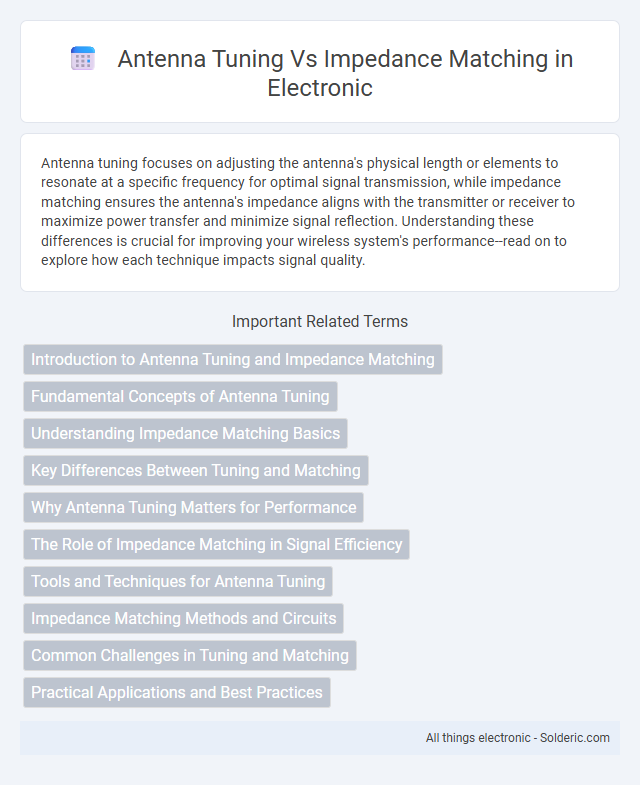Antenna tuning focuses on adjusting the antenna's physical length or elements to resonate at a specific frequency for optimal signal transmission, while impedance matching ensures the antenna's impedance aligns with the transmitter or receiver to maximize power transfer and minimize signal reflection. Understanding these differences is crucial for improving your wireless system's performance--read on to explore how each technique impacts signal quality.
Comparison Table
| Aspect | Antenna Tuning | Impedance Matching |
|---|---|---|
| Definition | Adjusting antenna parameters to achieve resonance at a specific frequency. | Connecting a network to minimize reflection by matching load impedance to source impedance. |
| Purpose | Optimize antenna performance and bandwidth. | Maximize power transfer and reduce signal loss. |
| Key Parameters | Resonant frequency, antenna length, physical dimensions. | Impedance values (resistance and reactance). |
| Techniques | Using adjustable elements like coils, capacitors, or physical length changes. | Employing matching networks such as L-networks, transformers, or baluns. |
| Application | Ensuring antenna resonates at target frequency for efficient radiation. | Ensuring maximal power delivery between transmitter/receiver and antenna. |
| Measurement Tools | SWR meter, antenna analyzer. | Impedance analyzer, network analyzer. |
| Effect on System | Improves antenna radiation efficiency and signal clarity. | Reduces reflection and standing waves, increasing system reliability. |
Introduction to Antenna Tuning and Impedance Matching
Antenna tuning involves adjusting the physical length or elements of an antenna to achieve resonance at a specific frequency, optimizing its performance for transmission or reception. Impedance matching, on the other hand, ensures the antenna's impedance aligns with the transmission line and radio equipment to minimize signal reflection and power loss. Your communication system benefits from both processes to maximize efficiency and signal clarity.
Fundamental Concepts of Antenna Tuning
Antenna tuning involves adjusting the antenna's physical or electrical parameters to achieve resonance at a specific frequency, optimizing signal transmission and reception. Impedance matching ensures the antenna's impedance aligns with the transmission line or receiver, minimizing signal reflection and power loss. Understanding the fundamental concepts of antenna tuning requires knowledge of resonant frequency, antenna reactance, and the ability to manipulate elements like antenna length or loading coils for optimal performance.
Understanding Impedance Matching Basics
Impedance matching ensures maximum power transfer between your antenna and transmission line by aligning their resistive and reactive components. Proper antenna tuning adjusts the resonant frequency and reactance to achieve this match, minimizing signal reflection and loss. Understanding these basics helps optimize antenna performance and improve overall communication efficiency.
Key Differences Between Tuning and Matching
Antenna tuning adjusts the antenna's physical length or reactive components to achieve resonance at a specific frequency, minimizing the reactive part of the impedance. Impedance matching involves using matching networks like transformers, stubs, or LC circuits to ensure the antenna's complex impedance aligns with the transmission line or transmitter, maximizing power transfer and minimizing standing wave ratio (SWR). While tuning targets the antenna itself for optimal resonance, impedance matching optimizes the interface between antenna and transmission system for efficient signal transfer.
Why Antenna Tuning Matters for Performance
Antenna tuning directly impacts signal strength and transmission efficiency by ensuring the antenna operates at its optimal resonant frequency. Proper tuning minimizes reflected power and maximizes energy transfer between the transmitter and antenna, enhancing overall system performance. Impedance matching alone reduces signal loss, but tuning aligns the antenna's electrical length with the desired frequency, critically improving reception and transmission quality.
The Role of Impedance Matching in Signal Efficiency
Impedance matching plays a crucial role in signal efficiency by minimizing signal reflection and maximizing power transfer between the antenna and the transmitter or receiver. Proper impedance matching ensures that the antenna's impedance aligns with the characteristic impedance of the transmission line, typically 50 ohms, reducing standing wave ratio (SWR) and energy losses. Effective impedance matching directly enhances antenna tuning performance, leading to clearer signal transmission and improved communication reliability.
Tools and Techniques for Antenna Tuning
Antenna tuning involves adjusting the antenna length, position, or components to resonate at the desired frequency using tools like antenna analyzers, network analyzers, and SWR meters that measure standing wave ratio and impedance. Impedance matching relies on devices such as baluns, inductors, capacitors, and adjustable matching networks like LC circuits or antenna tuners to minimize reflection and maximize power transfer between the antenna and transmitter. Advanced techniques integrate vector network analyzers for detailed impedance plots and automated antenna tuners for real-time adaptive matching in dynamic environments.
Impedance Matching Methods and Circuits
Impedance matching methods involve techniques such as transformer coupling, LC networks, and transmission line stubs designed to optimize the transfer of power between the antenna and transmitter by minimizing reflection and signal loss. Common impedance matching circuits include L-networks, Pi-networks, and T-networks, each selected based on frequency range and load conditions to achieve desired input impedance. Properly tuning these circuits ensures maximum efficiency in Your antenna system, leading to improved signal strength and reduced SWR (Standing Wave Ratio).
Common Challenges in Tuning and Matching
Common challenges in antenna tuning and impedance matching include dealing with complex reactive components that cause signal reflection and power loss. Variations in environmental factors and cable lengths often lead to impedance mismatches, reducing antenna efficiency. Achieving optimal resonance frequently requires precise adjustments to antenna length or matching network components to minimize Standing Wave Ratio (SWR) and maximize power transfer.
Practical Applications and Best Practices
Antenna tuning and impedance matching are crucial for maximizing signal strength and minimizing power loss in radio frequency systems. Practical applications include adjusting antenna length or using matching networks like LC circuits and transformers to align antenna impedance with transmitter output, ensuring optimal energy transfer and reducing VSWR (Voltage Standing Wave Ratio). Best practices involve precise measurement with network analyzers and iterative adjustments in real-time environments to accommodate frequency shifts and environmental changes for sustained communication efficiency.
antenna tuning vs impedance matching Infographic

 solderic.com
solderic.com